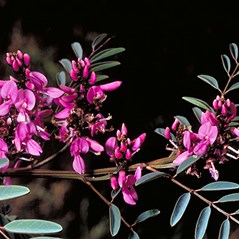Uses: As an understorey plant in a mixed border or mass plant in groups.
It can be lightly pruned to cover an embankment, although pruning into old wood should be avoided.
Fragrant flowers, attracts native butterflies, caterpillar food source.
Cultural use: Indigenous peoples hammered the roots and placed in salt or fresh water to poison fish.
Note: This species is provisionally classified schedule 1, Regulation 24.2 under the Sewerage Act. Written approval is required prior to planting in streets or roads. It should not be planted closer than two metres to any sewer main or connection.
This plant is indigenous to the following botanical regions of South Australia.
:NW: North Western
:LE: Lake Eyre
:GT: Gairdner-Torrens
:FR: Flinders Rangers
:EA: Eastern
:EP: Eyre Peninsula
:NL: Northern Lofty
:MU: Murray
For detail on these regions refer to the user guide.
- Height 1.5-3m
- Spread 1-3m
- Position
- Full Sun
- Family Fabaceae
- Botanical Name Indigofera australis
- Common Name Austral indigo
- Origin SA, Vic, NSW, WA,
- Habit Upright, Open, Arching
- Landscape Coastal footslopes, 2nd line coast, Hills, Plains
- Soil Texture Clay, Loam, Sand
- pH Acidic, Alkaline, Neutral
- Tolerates Drought, Moderate frost
- Supplementary Watering Minimal
- Flower Colour Pink
- Flowering Time Spring, Winter
- Flower Type Pea
- Purpose Habitat, Ornamental
- Evergreen/Deciduous Evergreen
- Form Medium Shrub (Usually between 1.2m & 3.6m)
- Indigenous to the Adelaide Region







